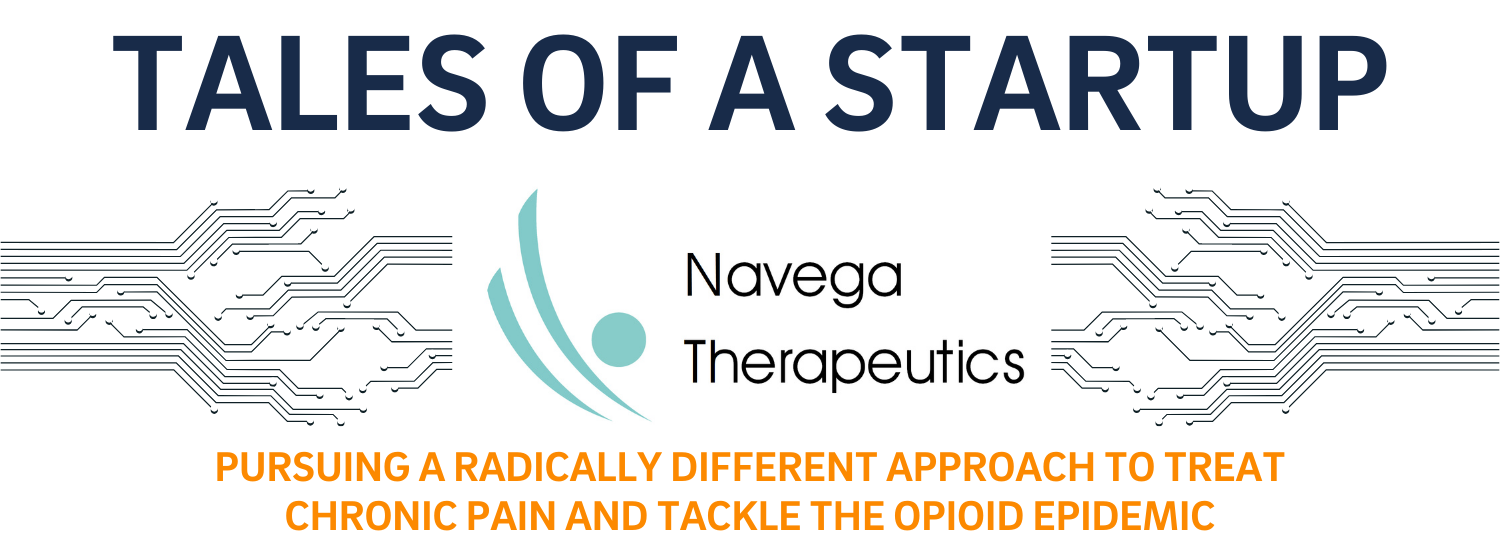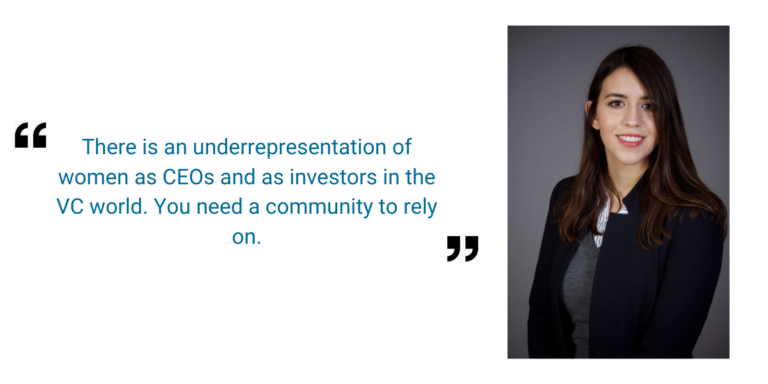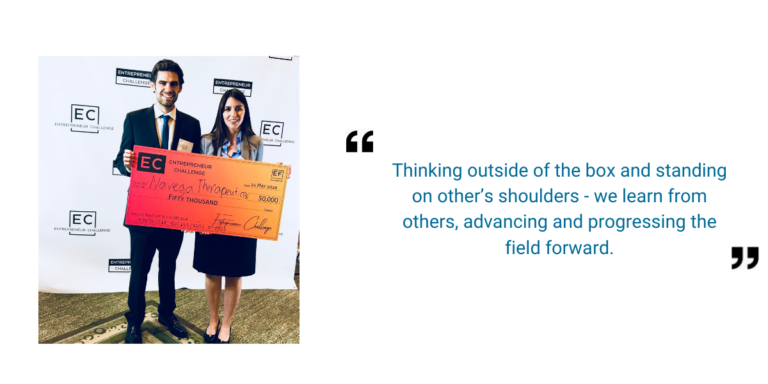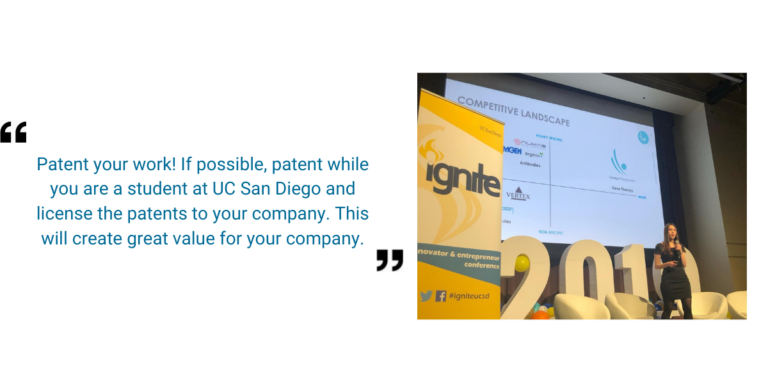
Bioengineering Alumna Ana Moreno Pioneers Epigenetic Gene-Therapy Technology As An Answer to Chronic Pain
May 28, 2021
UC San Diego licensed Navega Therapeutics is pursuing a radically different approach to treat chronic pain and tackle the opioid epidemic.
From lab to clinic, Ana Moreno has always been excited about gene therapy, fascinated with translational medicine as a PhD student in Bioengineering. Gene editing has shown great promise as a non-heritable way to treat a wide range of conditions, including many genetic diseases and most recently COVID-19. Epigenetic editing offers a safer alternative to genome modification.
Currently, 30% of Americans are living with some form of chronic or severe pain. Navega Therapeutics is answering those pains with a CRISPR epigenetic gene-therapy tool, helping to deliver long-lasting pain relief without the risk of addiction associated with prescription opioid drugs. The company has developed a gene therapy to target pain that is non-addictive, highly specific, and long-lasting.
This novel approach to treating chronic pain was authored by Moreno while a student in the NIH-supported lab of Prashant Mali at UC San Diego. Her journey has taken her across campus, incorporating in the midst of a PhD, to find her home at JLABS San Diego where she is developing a novel gene therapy to market to aid millions of Americans.
Read more on her journey from lab to market below.
What has been your experience with UC San Diego and its diverse entrepreneurial culture?
I’ve always been interested in translational research, and it was while I was working on my PhD, that we decided to start a company based on our exciting data demonstrating that our gene therapy could reverse chronic pain in animal models of pain. Knowing that I had no background in business, I decided to do some research about the opportunities available on campus. I learned that the Institute for the Global Entrepreneur was in the same building as my lab, and I took advantage of several of its programs including the Technology Accelerator program and NSF I-Corps program in 2018, which helped me develop general business concepts, my first pitch deck. Something I learned early on was that as a scientist you think everyone will want and pay for your therapy. However, as you commercialize your product, you need to understand your patient population, the payer, and how key opinion leaders think about your therapy and its translation into the clinic.

I also enrolled in Rady’s StartR Inclusion (previously mystartupxx), in which I was able to meet other female UC San Diego founders, as well as business leaders. I enjoyed networking and sharing ideas with fellow female founders. The program excels at bringing like-minded women into the community, as well as an opportunity for minorities to see themself in the landscape. There is an underrepresentation of women as CEOs and as investors in the VC world. You need a community to rely on. Lab to Market @ Rady was also fantastic, bringing together engineers with MBA students, preparing ourselves for first meetings with investors - what is the problem we are trying to solve, what is our competitive advantage, what is our ask, what is our budget, how will we budget!
What excites you about your work?
Being able to help someone with your research is incredibly exciting. Gene therapies have traditionally focused on rare disease. I am excited about tackling common diseases, which should be the next chapter of gene therapies. Chronic pain is a huge market, and we need innovative therapies to tackle that problem. Many patients have reached out to ask if they can be part of our clinical trials for chronic pain. It keeps me going. If I can get something to the clinic, I think I can retire!
Describe a typical day in Startupland. What does your day look like?
It’s true when they say that you wear many hats when you work in a startup. My main focus is on fundraising—writing grants, talking to advisors and investors. I also manage employees, speak at conferences and events, and have calls with collaborators and companies providing services. There are many Zoom calls! Additional hats I wear include planning and running experiments in the lab, HR, writing patents. No two days are the same! I would say grad school prepares you for startup life. You work Monday-Sunday, at odd hours, and you’re driven by passion for your work.
How do you define innovation in the 21st Century?

Thinking outside of the box and standing on other’s shoulders - we learn from others, advancing and progressing the field forward.
Specific to our work, I would say innovation is not just on the technology we are working on—epigenetic gene therapies for common disease—but also on commercialization. How can we make gene therapy affordable?
What role have mentors played in your success/journey?
I have been very lucky to have had amazing mentors. My PhD advisor, Prashant Mali, has been pivotal. I was able to pursue a project I was passionate about due to him being open minded and supportive of his students taking their research in innovative and challenging areas.
Kim Davis King, Lada Rasochova, and Vish Krishnan were great mentors at Rady, who exposed me to initial concepts in business. I’ve also found great mentors that have been biopharma executives, including Jeffrey Ostrove and Randy Woods. They have been very generous with their time and have guided me into this new world of entrepreneurship! I hope to be able to pay it forward and mentor others interested in pursuing a similar path.
What are some of the biggest challenges you faced in the startup process? How were you able to overcome them?
The biggest challenge has been the fundraising process. What I’ve learned is that you always need more time and money than you think you’ll need. I’ve also learned that this is a challenge for many companies and that networking is very important! Investors don’t only invest in great ideas, but also on the team! Challenges are the best learning experience.
What advice would you give to a UC San Diego student thinking about starting a company?
First, I would say, go for it! Now is the best time to start a company. Take advantage of all the resources on campus, including business classes at Rady and support from the IGE program. Also, take advantage of non-dilutive funding. Our first line of fundraising came from pitch competitions and through the IGE accelerator at UC San Diego. We then applied for NIH grants which helped us start hiring, renting lab space, generating data, etc.

Start networking and find people that share your vision—be it mentors, investors, partners. Patent your work! If possible, patent while you are a student at UC San Diego and license the patents to your company. This will create great value for your company. If the startup is based on your research at UC San Diego, finding the right advisor is key! Find an advisor that supports your vision of starting a company. Lastly, meet other entrepreneurs that you can relate to and share your journey with.
Navega is hiring! To learn more about open positions, check out: https://navegatx.com/en or email Ana at amoreno@navegatx.com